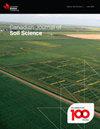Response to side-banded phosphorus and zinc fertilizer for corn grown after canola or soybean in southern Manitoba
IF 1.5
4区 农林科学
Q4 SOIL SCIENCE
引用次数: 0
Abstract
A two-year crop rotation study in southern Manitoba assessed the effects of starter fertilizer on grain corn (Zea mays L.) production when corn followed canola (Brassica napus L.) versus soybean (Glycine max L. Merr.). Treatments included a control (no starter) and two rates of phosphorus (P) (30 and 60 kg P2O5 ha-1) as monoammonium phosphate (MAP, 11-52-0) or MicroEssentials® SZ (MESZn, 12-40-0-10-1) side-banded at planting. The preceding crop did not have any influence on mycorrhizal colonization of corn roots at V4 corn growth stage. However, side-banded fertilizer increased early-season biomass by as much as 111% compared to the unfertilized control, with the largest increases occurring where corn followed canola. Phosphorus concentration and uptake in early-season biomass increased as the P rate increased. Zinc (Zn) concentrations in early-season biomass were greatest for the unfertilized control and MESZn treatments, while Zn uptake was significantly greater with the application of starter fertilizer compared to the unfertilized control. Starter P advanced silking date by 2 to 7 days relative to the unfertilized control. At maturity, starter P reduced grain moisture by 21 to 27 g kg-1 in corn, only after canola. The high rate of MAP increased grain yield by an average of 770 kg ha-1 compared to the unfertilized control, regardless of the preceding crop. The negative influence of the preceding canola crop on early-season growth and mid-season development of corn can be managed with starter fertilization, to provide adequate P and Zn to the corn crop and maintain successful production in Manitoba.曼尼托巴省南部油菜或大豆后玉米对侧带状磷锌肥的响应
在马尼托巴南部进行了一项为期两年的轮作研究,评估了玉米轮作油菜轮作玉米轮作大豆轮作甘氨酸轮作大豆轮作玉米轮作的发酵剂对玉米产量的影响。处理包括对照(无发菜)和两种磷(30和60 kg P2O5 ha-1),在种植时磷酸一铵(MAP, 11-52-0)或MicroEssentials®SZ (MESZn, 12-40-0-10-1)侧带状施用。在V4玉米生育期,前茬作物对玉米根系菌根定植没有影响。然而,与未施肥的对照相比,侧带状肥料使早季生物量增加了111%,其中玉米和油菜的增幅最大。随着施磷率的增加,早季生物量的磷浓度和吸收量增加。未施肥对照和MESZn处理的早季生物量锌含量最高,发酵肥处理的锌吸收量显著高于未施肥对照。发酵剂P比未施肥对照提前2 ~ 7天出丝。成熟时,发菜磷使玉米籽粒水分减少21 ~ 27 g kg-1,仅次于油菜。无论前茬作物如何,与未施肥的对照相比,MAP的高施用量平均增加了770公斤每公顷的粮食产量。在马尼托巴省,前茬油菜籽作物对玉米季前生长和季中发育的负面影响可以通过启动施肥来管理,为玉米作物提供充足的磷和锌,保持成功的生产。
本文章由计算机程序翻译,如有差异,请以英文原文为准。
求助全文
约1分钟内获得全文
求助全文
来源期刊

Canadian Journal of Soil Science
农林科学-土壤科学
CiteScore
2.90
自引率
11.80%
发文量
73
审稿时长
6.0 months
期刊介绍:
The Canadian Journal of Soil Science is an international peer-reviewed journal published in cooperation with the Canadian Society of Soil Science. The journal publishes original research on the use, management, structure and development of soils and draws from the disciplines of soil science, agrometeorology, ecology, agricultural engineering, environmental science, hydrology, forestry, geology, geography and climatology. Research is published in a number of topic sections including: agrometeorology; ecology, biological processes and plant interactions; composition and chemical processes; physical processes and interfaces; genesis, landscape processes and relationships; contamination and environmental stewardship; and management for agricultural, forestry and urban uses.
 求助内容:
求助内容: 应助结果提醒方式:
应助结果提醒方式:


